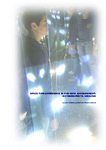Space-Time Experience in the Meta-Environment: A Cybersemiotic Analysis
| dc.contributor.supervisor | Ascott, Roy | |
| dc.contributor.author | Ferreira Jacques de Moraes Cardoso, Claudia | |
| dc.contributor.other | School of Art, Design and Architecture | en_US |
| dc.date.accessioned | 2019-03-29T15:45:39Z | |
| dc.date.available | 2019-03-29T15:45:39Z | |
| dc.date.issued | 2019 | |
| dc.identifier | 10300054 | en_US |
| dc.identifier.uri | http://hdl.handle.net/10026.1/13584 | |
| dc.description.abstract |
Space-time Experience in the Meta-environment: A Cybersemiotic Analysis Written from the perspective of a reflective technoetic art practitioner, this thesis investigates Human-Computer Interactions in interactive hybrid environments and their influences on mediated consciousness. It argues that practices established during the advent of computer graphic interfaces have limited the interactive potential of such environments. It examines interactive processes among user, information, and interface; proposes a closer look at representational paradigms of space and time; suggests potentially illuminating parallels with complex adaptive systems; and explores their theoretical and practical co-implications. Influenced by Marcel Duchamp’s conceptual-interactive art experiments, Brazil’s syncretic Tropicalismo movement, and Roy Ascott’s technoetic art, this thesis deploys Søren Brier’s Cybersemiotic framework to bridge practice and theory. It presents the interactive hybrid installation Mixing Realities (2009, 2014) as contemporary example, analyzing its physical and digital components, aesthetic and conceptual goals, and reception by various users. This thesis suggests that, as products of the mechanical age, space-time representational paradigms emphasizing embodiment rely on linear visualization and episodic memory, thereby restricting digital information’s potential and preventing more balanced integration among user, information, and interface--a triadic relationship identified as “meta-environment.” This thesis observes that current theoretical frameworks have dissonant understandings of information, communication, process, perception, and meaning, which impedes integration of user-information-interface in a manner that accords them equal weight and acknowledges their mutual influences. The current understanding is that information is either exclusively human perception or computer interface process. Søren Brier’s cybersemiotics integrates phenomenological perceptions and feedback processes, thereby enabling study of the meta-environment with focus on how individual elements influence one another in dynamic triadic relationships. Visual representations of this analysis suggest that each element at some point works as mediator of interactive processes. The possibility of understanding these interactions as dynamic complex adaptive systems creates the potential of expanding how humans interact, perceive space and time, and mediate consciousness. | en_US |
| dc.language.iso | en | |
| dc.publisher | University of Plymouth | |
| dc.rights | CC0 1.0 Universal | * |
| dc.rights.uri | http://creativecommons.org/publicdomain/zero/1.0/ | * |
| dc.subject | technoetic art | en_US |
| dc.subject | cybersemiotics | en_US |
| dc.subject | HCI | en_US |
| dc.subject | cybersemiotic experience | en_US |
| dc.subject | semiotic dance | en_US |
| dc.subject | cybernetics | en_US |
| dc.subject | semiotics | en_US |
| dc.subject.classification | PhD | en_US |
| dc.title | Space-Time Experience in the Meta-Environment: A Cybersemiotic Analysis | en_US |
| dc.type | Thesis | |
| plymouth.version | publishable | en_US |
| dc.identifier.doi | http://dx.doi.org/10.24382/537 | |
| dc.identifier.doi | http://dx.doi.org/10.24382/537 | |
| dc.rights.embargoperiod | No embargo | en_US |
| dc.type.qualification | Doctorate | en_US |
| rioxxterms.version | NA |
Files in this item
This item appears in the following Collection(s)
-
01 Research Theses Main Collection
Research Theses Main



